Designed to safeguard both the engine and occupant bay our system integrates advanced detection, alarm, and suppression technologies providing comprehensive, customized protection for school, staff, and long-distance passenger buses, making it ideal for both Indian and global markets.
FDAS & FDSS For Engine Bay
Our Fire Detection and Alarm System (FDAS) and Fire Detection and Suppression System (FDSS) are engineered for high-risk zones, such as the engine bay in I.C.E. (Internal Combustion Engine) buses. Designed to ensure rapid detection, swift suppression, and minimal collateral damage, these systems comply with AIS-135 standards for school, staff, and long-distance passenger buses. Our solutions provide reliable, regulation-compliant fire safety, ideal for both Indian and global markets.

Fire Strobe Siren
- Loud audible alert (90dB) for immediate evacuation
- Bright strobe light enhances visibility in smoke or low light
- EMI/EMC certified

Control Panel
- Automatically triggers suppression on abnormal temperature rise
- Compatible with upto three zones
- EMI/EMC Certified

Heat Linear Cable
- Activates at 187°C, triggering suppression within 10 seconds
- Built to endure vibration, heat cycles and harsh engine conditions.
- UL Approved

Foam-Based Suppression Agent
- Forms a thick foam blanket that cuts off the oxygen supply
- Creates a long-lasting barrier to prevent re-ignition
- Discharges at a pressure of 18–20 bar for fast suppression
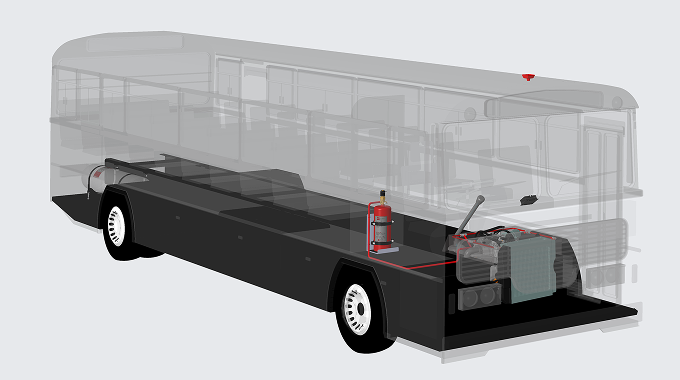 +
+
+
+
+
+
+
+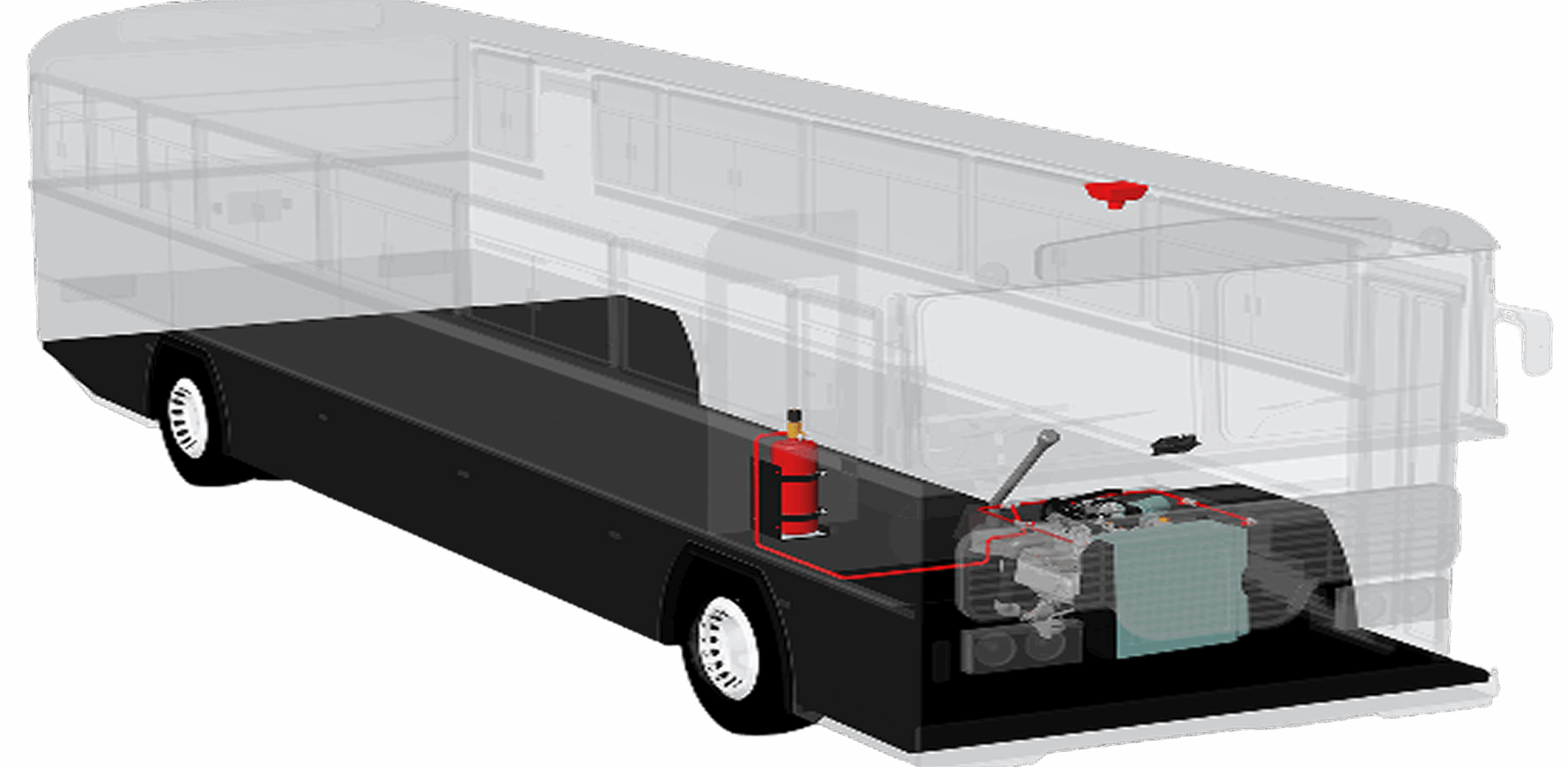
Explain how the system works?
The Linear Heat Detection (LHD) detects heat on fire along the engine bay. When the temperature exceeds a ser threshold the cable sends a signal is the control panel triggering the fire detection system
The control panel displays a fire indicator for the battery compartment, and the buzzer alarm sounds to alert the operator
The suppression system is activated automatically when the LHS detect the temperature rise triggering the discharge of foam based suppressant to supparss the fire
If the system fails to activate automatically, the operator can manually release SNF Lith+ by pressing the control panel button or pulling the pin on the cylinder to open the solenoid valve.
The alarm will continue to sound until the operator presses the “accept” button on the control panel to silence it.
In case of a false alarm or error, the operator can silence the alarm by pressing the “accept” button, correct the issue, and press the “reset” button to restore system functionality.
Explain how the system works?
01
Fire Detection
The Linear Heat Detection (LHD) cable senses abnormal heat in the battery pack and triggers the fire detection system when temperatures exceed a set threshold.
02
Fire Alarm Activation
The control panel displays a fire indicator for the battery compartment, and the buzzer alarm sounds to alert the operator
03
Alarm Acknowledgment
The suppression system automatically activates when the LHD cable detects a temperature rise releasing SNF LITH+ a lithium-ion battery fire suppressant
04
Manual Activation (If Automatic Fails)
If the system fails to activate automatically, the operator can manually release SNF Lith+ by pressing the control panel button or pulling the pin on the cylinder to open the solenoid valve.
05
Error or False Alarm Handling
In case of a false alarm or error, the operator can silence the alarm by pressing the “accept” button, correct the issue, and press the “reset” button to restore system functionality.
06
Automatic Suppression Activation
The The alarm will continue to sound until the operator presses the”accept” button on the control panel to silence it.
Explain how the system works?
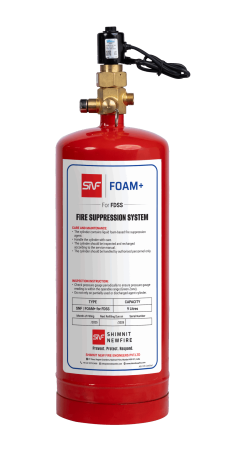
FOAM+
Foam-Based Suppression Agent
- Forms a thick foam blanket that cuts off the oxygen supply
- Rapidly cools the fire and surrounding components
- Creates a long-lasting barrier to prevent re-ignition
- Discharges at a pressure of 18–20 bar for fast suppression
- Typical spray duration: 5–10 seconds, depending on configuration
- Leaves minimal residue, ensuring quick post-fire cleanup
- Non-corrosive and safe for use around electronics
- Available in 6/9 Liters
FOAM+
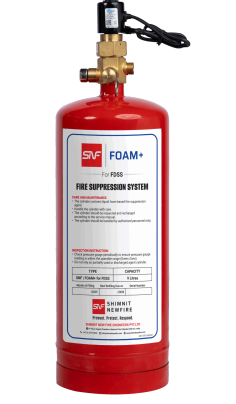
Foam-Based Suppression Agent
- Forms a thick foam blanket that cuts off the oxygen supply
- Rapidly cools the fire and surrounding components
- Creates a long-lasting barrier to prevent re-ignition
- Discharges at a pressure of 18–20 bar for fast suppression
- Typical spray duration: 5–10 seconds, depending on configuration
- Leaves minimal residue, ensuring quick post-fire cleanup
- Non-corrosive and safe for use around electronics
- Available in 6/9 Ltrs
Frequently asked Questions
What is FDAS and FDSS?
FDAS (Fire Detection and Alarm System) and FDSS (Fire Detection and Suppression System) are advanced fire safety systems designed for high-risk zones like engine bays in Internal Combustion Engine (I.C.E.) buses. They provide rapid fire detection, swift suppression, and comply with AIS-135 standards.
How does the system detect a fire?
A Linear Heat Detection (LHD) cable senses abnormal temperature rise in the engine bay. When it crosses the threshold, it signals the control panel, triggering the alarm and suppression system.
What happens when a fire is detected?
The control panel shows a fire alert and activates an audible buzzer. Simultaneously, the suppression system discharges foam to contain the fire automatically.
Can the system be manually activated?
Yes. If automatic suppression fails, the operator can press the manual activation button on the control panel or pull the pin on the suppressant cylinder to release the agent
How is a false alarm or error handled?
The alarm continues until the operator acknowledges it by pressing “accept” and then “reset” after resolving the issue to restore normal function.
What type of suppressant is used in FDSS?
A foam-based agent is used, which:
- Forms a thick barrier to cut off oxygen
- Rapidly cools the fire and components
- Prevents re-ignition
- Discharges at 18–20 bar within 5 10 seconds
- Leaves minimal residue
- Is safe around electronics
Is the system durable for transport use?
Absolutely. It’s built for rugged performance in harsh environments, offering:
- Protection to vehicle components
- during fires
- Reduced downtime
- Low maintenance
- Long service life
What components are included in the system?
Control Panel (supports up to 3 zones, EMI/EMC certified)
- Fire Strobe and Siren (90dB alert, visible in smoke)
- Linear Heat Detection Cable (activates at 187°C, UL approved)
- Foam-based suppressant cylinders (6 or 9 liters)
What certifications does the system have?
The systems are AIS-135 compliant and certified by CIRT. Key components like the heat cable are UL approved, and all electronics are EMI/EMC certified.
Where is this system typically installed?
Primarily in the engine bays of I.C.E. buses, which are high-risk fire zones due to heat and flammable fluids
FAS & FPS For Occupant Bay
Our Fire Alarm System (FAS) and Fire Protection System (FPS) are designed to deliver reliable and rapid fire response in the occupant bay of buses. Developed with technology transfer from CFEES-DRDO, the system integrates detection, alarm, and suppression components to ensure comprehensive passenger safety. Ideal for long-distance and school buses, it meets AIS-135 standards and aligns with international fire safety benchmarks, making it suitable for deployment in both Indian and global markets.

Control Panel
- Automatically triggers suppression on abnormal temperature rise
- Compatible with upto three zones
- EMI/EMC Certified

Fire Strobe Siren
- Loud audible alert (90dB) for immediate evacuation
- Bright strobe light enhances visibility in smoke or low light
- EMI/EMC certified

Water Mist Nozzle
- Tested and certified by CFEES-DRDO
- Atomizes water into ultra-fine mist for effective fire suppression
- Provides a minimum 3-minute spray duration
- Delivers 1.65 L/min at 7 bar pressure
- Constructed from SS 304/316 with a 90°+ spray angle for wide coverage

Optical/Heat Multisensor Detector
- Combines smoke and heat sensing for rapid detection
- Dust compensation minimizes false alarms
- Operates between -40°C to +70°C

Suppression Agent Cylinder – Occupant Bay
- Stainless steel (SS) construction for water-based agent; corrosion-resistant
- Heavy-duty bracket ensures secure, vibration-resistant mounting
- Available in multiple sizes for buses with 20m3 to 80m3
- Modular configuration for flexible bus integration

Nitrogen Cylinder
- Available in 6.8L, 10.2L, and 13.5L capacities
- Built to perform in rugged, mobile environments
- Vibration-resistant installation ensures stability in transit
- Petroleum and Explosives Safety Organization (PESO) approved
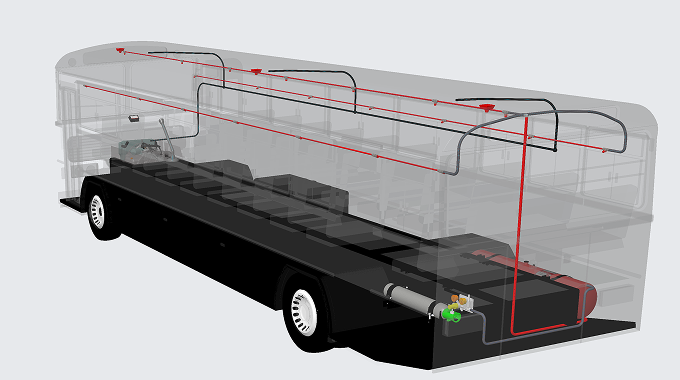 +
+
+
+
+
+
+
+
+
+
+
+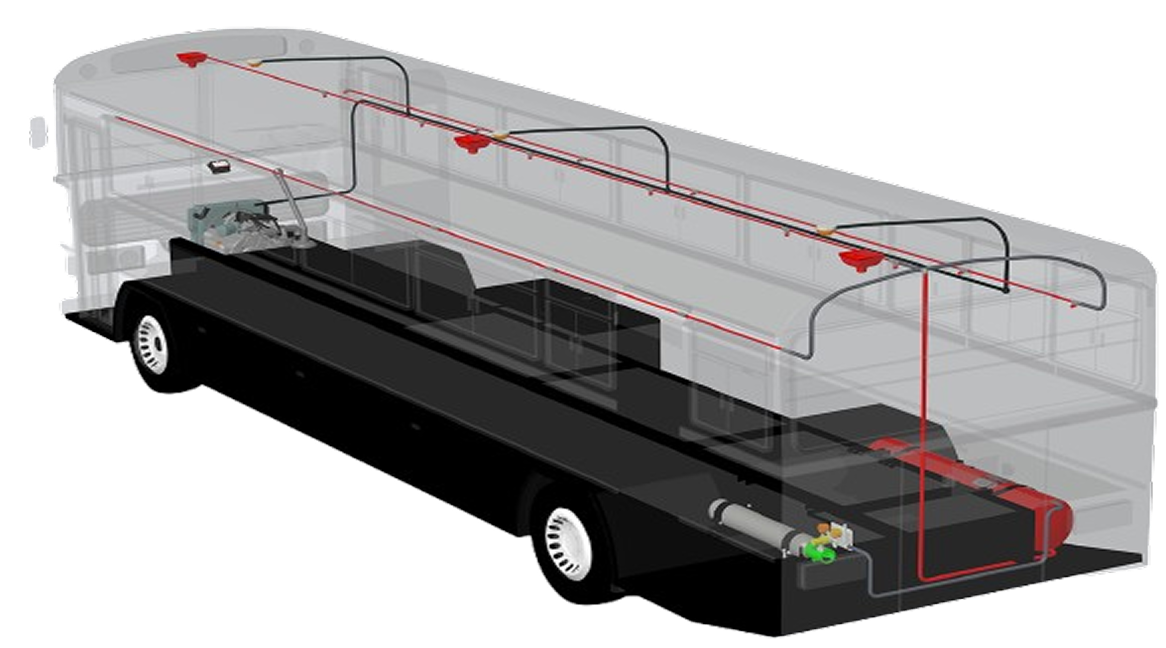
Explain how the system works?
The smoke detector detects smoke in the occupant bay (passenger area)
The control panel displays a fire indicator for the occupant zone and the buzzer alarm sounds
The operator presses the “accept” button to silence the alarm
This system sprays water for a minimum of 3 minutes, controlling the fire and reducing smoke in the bus, allowing passengers to evacuate
For added safety, the mist system can also be activated by manually opening the valve on the N, Tank at the rear of the bus, ensuring continuous protection
The operator can stop the alarm by pressing the “Accept” button, rectify the error, and then press the “reset” button to restore the system’s functionality
Frequently asked Questions
What is the FAS & FPS system?
FAS (Fire Alarm System) and FPS (Fire Protection System) are integrated automatic fire safety solutions designed to detect and suppress fires in the occupant bay (passenger area) of buses, particularly for long-distance and school buses.
What standards does the system comply with?
The system complies with AIS-135 standards and aligns with international fire safety benchmarks, making it suitable for both Indian and global markets
How does the system detect a fire?
The system uses a multisensor detector that combines smoke and heat sensing. This ensures fast and reliable detection of fire or smoke in the occupant bay.
What happens when smoke is detected?
- The control panel displays a fire alert.
- A buzzer alarm and strobe siren are triggered.
- The operator can press the “Accept” button to silence the alarm.
How is the fire suppressed?
The system automatically activates water mist nozzles which spray ultra-fine water mist for at least 3 minutes, controlling fire and smoke to allow safe evacuation.
Is there a manual override?
Yes. A manual valve at the nitrogen (N₂) tank allows the mist system to be activated in case of emergency or if the automatic function fails.
Can false alarms be managed?
Yes. The operator can:
- Press “Accept” to silence the alarm
- Identify and rectify the issue
- Press “Reset” to restore the system
What kind of nozzles are used in the FPS?
The system uses CFEES–DRDO tested water mist nozzles that:
- Atomize water for effective suppression
- Provide 1.65 L/min output at 7 bar pressure
- Have a wide 90°+ spray angle
- They are made from SS 304/316 for durability
Explain how the system works?
Explain how the system works?
Frequently asked Questions
Can the system be manually activated?
Yes. If automatic suppression fails, the operator can press the manual activation button on the control panel or pull the pin on the suppressant cylinder to release the agent
How is a false alarm or error handled?
The alarm continues until the operator acknowledges it by pressing “accept” and then “reset” after resolving the issue to restore normal function.
Is the system durable for transport use?
Absolutely. It’s built for rugged performance in harsh environments, offering:
- Protection to vehicle components during fires
- Reduced downtime
- Low maintenance
- Long service life
Where is this system typically installed?
Primarily in the engine bays of I.C.E. buses, which are high-risk fire zones due to heat and flammable fluids.
What standards does the system comply with?
The system complies with AIS-135 standards and aligns with international fire safety benchmarks, making it suitable for both Indian and global markets
Is there a manual override?
Yes. A manual valve at the nitrogen (N₂) tank allows the mist system to be activated in case of emergency or if the automatic function fails.
Can false alarms be managed?
Yes. The operator can:
- Press “Accept” to silence the alarm
- Identify and rectify the issue
- Press “Reset” to restore the system
What kind of nozzles are used in the FPS?
The system uses CFEES–DRDO tested water mist nozzles that:
- Atomize water for effective suppression
- Provide 1.65 L/min output at 7 bar pressure
- Have a wide 90°+ spray angle
- They are made from SS 304/316 for durability